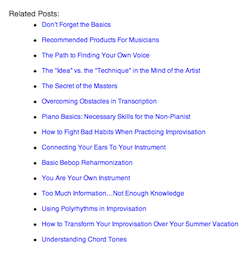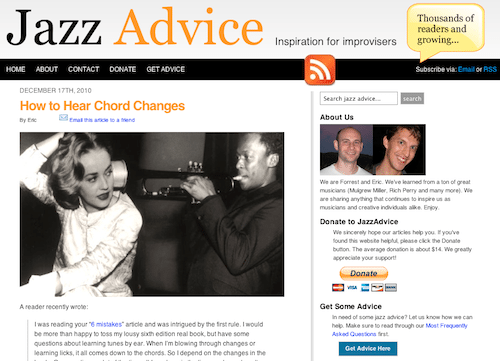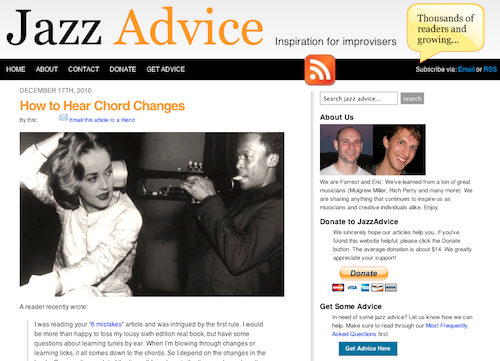Continuing in our series of ear training site profiles…

Intro
Jazzadvice.com is, unsurprisingly, a blog full of jazz advice. You probably didn’t need this article to tell you that, but the internet’s full of jazz ‘advice’ and you can waste a lot of time browsing blog after blog looking for some legitimately helpful stuff. So I’m hoping to save you those wasted hours by giving you a link to a good blog on jazz technique and, of course, a few notes about its best features.
Note: Many of the site’s articles are jazz-specific, targeting the modern jazz musician – but plenty is actually relevant to any keen musician, so don’t be afraid to dive in!
How to use it

JazzAdvice.com’s related articles are great – but can overwhelm!
Since the site is a blog rather than an interactive app, the logistical how-to is pretty simple compared to the other ear training sites featured in this series. But as the jazzadvice.com authors like to point out, becoming overwhelmed is a sure way to eliminate real progress. And it’s certainly possible to be overwhelmed here! For example, the lists of related articles at the end of each post almost always have a few really intriguing links, to such a point that it can become a bit difficult just to stop browsing…
What You’ll Learn
This is what makes jazzadvice.com stand out from its peers: recognizing the abundance of dry music theory how-tos, these guys focus instead on a more qualitative level. Instead of teaching the rules, they aim to show you a new perspective on them.
And that’s a great idea. Music theory is not a terribly difficult language to learn, but it’s really easy to get lost in the terminology. Especially if you’re just starting out, there’s nothing better than having an interpreter around to say “OK, so now you know how to form a sus4, here’s a few reasons why it’s important to know, and a few examples of where you should try using them.” Without that, you’re likely to get bored and frustrated. These writers do a great job of reframing the concept of “musical rules” as a set of tools, among many other fresh approaches to the process of learning theory and improvisation.
There are also several articles on specific pieces of advice from legendary players—Dizzy Gillespie’s essentials for improvising, for example. This is especially great insight for a modern jazz musician, because the way we teach and learn music theory has drastically changed in the decades since Dizzy. Now we approach jazz like it’s a form of calculus, learning technicalities in packed classrooms and often finding ourselves intimidated by the sheer amount of information. But learning from the greats usually comes with an excellent reminder: despite all the complicated elements there are to be learned, the really transcendent stuff comes from players who, more than anything, just feel it. The path to that ability, as you likely know if you’re browsing this site, is ear training.
And the site has plenty to say on the subject of ear training! Here are a few great starting points:
- Great Jazz Ears
- If you can sing happy birthday you can transcribe your favorite solo
- Fundamental Ear Training: Seventh Chords
Suggestions
As with any music blog, the most important thing is to walk in with an open mind. Remember that no two jazz musicians have ever achieved greatness by the same exact path, so it’s likely that any assortment of jazz advice will be a bit hit and miss. Some suggestions may seem less helpful than others, but you’re bound to find useful tips if you look for articles that really apply to where you’re at in your playing and aural skills training.
Summary
This is a big blog. There are a lot of posts, and they deal with diverse topics in jazz playing—some of which are hard to find elsewhere on the Internet. Unless you’ve got nothing left to learn, you’ll definitely find something of interest here. And if you’ve got nothing else to learn… Ha, I don’t believe you!
What d’you think of JazzAdvice.com? Any favorite articles to share? What do you think about combining jazz studies with ear training? Leave a comment below!








